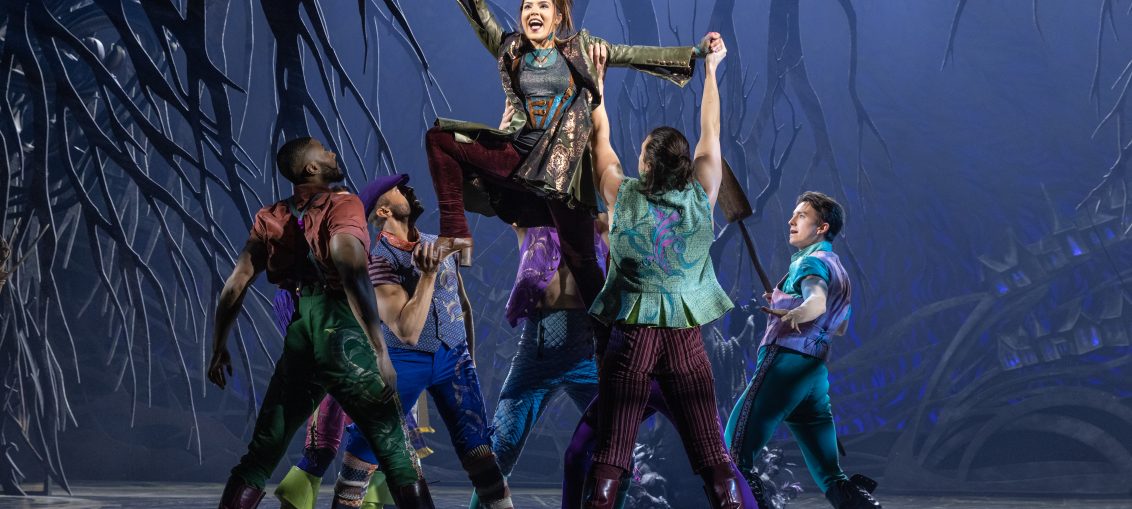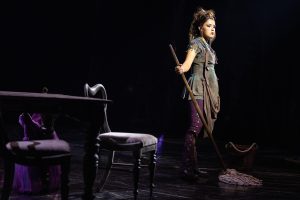
Yet again, Andrew Lloyd Webber has created a musical with a titular protagonist rejected by mainstream society for not meeting popular beauty standards—but unlike The Phantom of the Opera, Bad Cinderella eschews gothic melodrama in favor of silliness, aiming for laughs that it rarely earns.
The setting of this adaptation is Belleville, a town where beauty is prioritized above all else. Only two people in the town do not live up to the community’s surface standards: Cinderella and Prince Sebastian, the new heir to the throne since the disappearance of his older brother Prince Charming. The two, of course, are best friends from way back (how a nobleman’s daughter who works as her family’s servant became friends with a prince is never addressed), and are clearly the right kind of outcasts for one another—if only they weren’t too proud to admit their feelings.
 This Cinderella is not content to sit in her own little corner in her own little chair—instead, she spray paints graffiti and mouths off to royalty. She’s a nonconformist—but refusing to conform can’t be a character’s only trait. If, like Belle in Beauty and the Beast, she had a passion for literature or, like Ariel in The Little Mermaid, she was fascinated by an unreachable world, she might be a compelling character. The musical’s book, by Oscar-winner Emerald Fennell (who penned the brilliantly complex Promising Young Woman) gives Cinderella no such depth. In trying to make her more proactive than Rodgers and Hammerstein’s passive heroine, Webber and Fennel (and lyricist David Zippel, who rhymes the heroine’s name with “salmonella”) simply make her two-dimensional in the opposite way. A complex heroine can’t simply be abrasive—she needs some goals that she can aim for. It’s telling that Fennell, Zippel and Webber do not give this Cinderella an “I want” song early in the show. Instead, she gets an angry anthem of defiance that, dropped into another show, could easily be a villian’s song.
This Cinderella is not content to sit in her own little corner in her own little chair—instead, she spray paints graffiti and mouths off to royalty. She’s a nonconformist—but refusing to conform can’t be a character’s only trait. If, like Belle in Beauty and the Beast, she had a passion for literature or, like Ariel in The Little Mermaid, she was fascinated by an unreachable world, she might be a compelling character. The musical’s book, by Oscar-winner Emerald Fennell (who penned the brilliantly complex Promising Young Woman) gives Cinderella no such depth. In trying to make her more proactive than Rodgers and Hammerstein’s passive heroine, Webber and Fennel (and lyricist David Zippel, who rhymes the heroine’s name with “salmonella”) simply make her two-dimensional in the opposite way. A complex heroine can’t simply be abrasive—she needs some goals that she can aim for. It’s telling that Fennell, Zippel and Webber do not give this Cinderella an “I want” song early in the show. Instead, she gets an angry anthem of defiance that, dropped into another show, could easily be a villian’s song.
Which is not to say that some of the changes from the original fairy tale (and other adaptations of the fairy tale) aren’t good. This version eschews a magical fairy godmother in favor of a fashionista who makes all of her clients look identically attractive. Cinderella’s transformation is therefore not supernatural—instead, she forces herself into an uncomfortable dress and crippling high-heeled shoes, exactly like millions of women do the world over every single day.
And perhaps this is the most frustrating part about the show: It could have been really good. The idea of turning the Cinderella legend into a parable about superficiality and conformity is quite clever and timely. Especially as identity politics take on a bigger part in the social discourse, a musical about staying true to oneself as a way to be happy is certainly appropriate and could be a good start to a conversation about balancing individuality with mutual respect.
And there are some elements of the show that are genuinely fun, like the gang of uber-macho male courtiers working out shirtless and praising the lost Prince Charming as a “man’s man man.” It’s silly and enjoyable, but it doesn’t quite reach the levels of camp that other cult shows—like last season’s Diana—achieved.
The cast also helps elevate the show above its weak score and book, although one can’t help but wonder what the performers could have done with better material. Linedy Genao makes an appealing Cinderella, but her character doesn’t have much room to grow or change. Carolee Carmello steals every moment she is onstage as the Wicked Stepmother, demonstrating once again how she can wring laughs from even the weakest writing. (To see her go from playing a terrifying John Dickinson in 1776 earlier this season to a very funny Wicked Stepmother in just a few months speaks volumes about her skill.)
Sami Gayle and Morgan Higgins have good comic chemistry as the stepsisters, Christina Acosta Robinson gets a few good moments as the Godmother and Grace McLean earns some laughs, but they can’t overcome the weak dialogue and trite songs. Gabriela Tylesova’s extravagant sets and costumes evoke the best excesses of the 1980s mega-musicals. Laurence Connor’s direction is adequate at best, but as with the cast, one must wonder what he could have accomplished with better material.
Ultimately, Bad Cinderella isn’t fun enough to be “so bad it’s good” or even a camp classic. When closing the London production last year, Weber described the run as an “costly mistake.” This version isn’t a solution.
 Wednesday, December 31, 2025
Wednesday, December 31, 2025